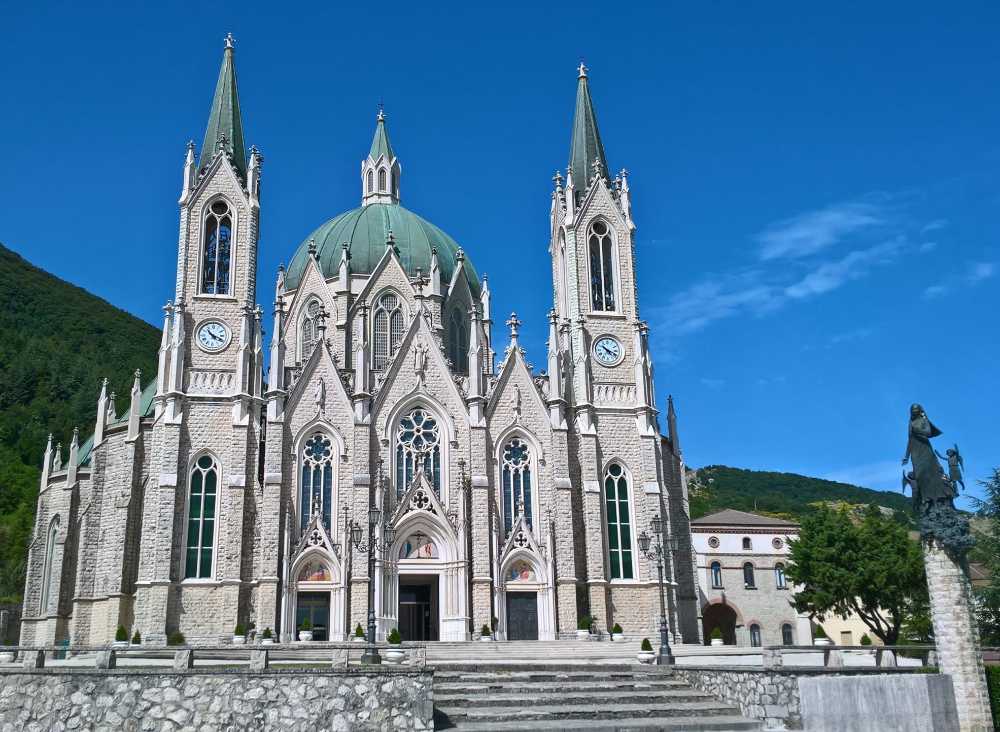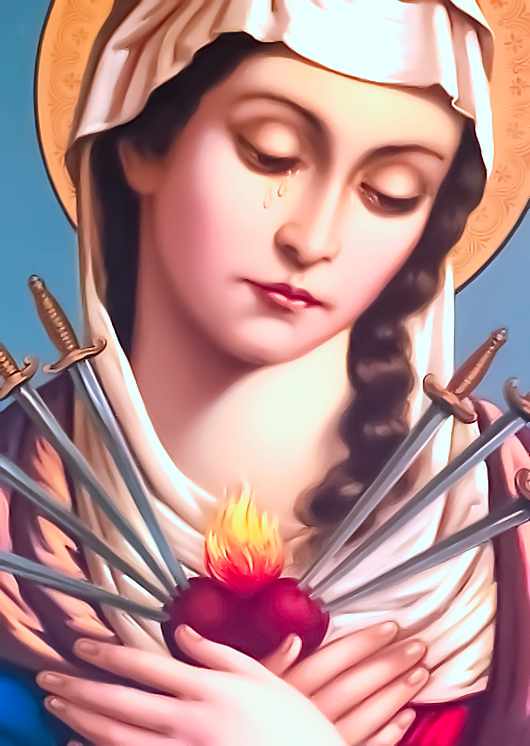The Apparitions of Our Lady at Castelpetroso
1888, Castelpetroso, Isernia, Molise, Italy
The First Apparition

Also here, as in Lourdes and Fatima, She chose the humble: Bibiana Cicchino, thirty-five years old, simple and honest peasant, born and resident in Castelpetroso, and Serafina Valentino, thirty-four years old, also born and resident in Castelpetroso.
On 22nd March 1888, while she is looking for a lost lamb, Bibiana, attracted by the glow that emanates from a cave, approaches, and immediately she is immersed in a celestial vision: the Blessed Virgin half kneeling, with her hands extended and her eyes turned to the sky is there, in an act of entreaty and offering; at her feet lies the dead Jesus covered with blood and wounds.
The news of the apparitions spread with the rapidity of a lightning bolt throughout Castelpetroso and spread in successive waves to all the nearby towns and regions. Crowds of faithful, as if struck by a thrill, felt driven to pilgrimage to the cave of Cesa tra Santi and their number grew day by day: the mountain soon gave the impression of a human anthill. A few days after the apparitions, about 4000 pilgrims came to Cesa tra Santi in a single day.
Bishop Francesco Palmieri
Bishop Francesco Palmieri, Bishop of Bojano, at the first manifestation of these extraordinary events, immediately put Cesa tra Santi under control and ordered a first preliminary process to investigate the alleged apparitions. Later on, the Holy Father Leo XIII himself, even if orally, appointed him as Apostolic Delegate, giving him the task of carrying out an inspection of the cave of the Apparitions on behalf of the Holy See.
On the morning of September 26, 1888, the Bishop went to the cave of Cesa among the Saints, and he too had the grace of seeing the Mother of Sorrows, in the same attitude described by the first two visionaries. These are his textual words: "With a happy spirit I can affirm that the portents of Castelpetroso are the last tracts of the Divine Mercy, to recall the misled to the right path. I too can testify that, when I went to the sacred place, focusing on prayer, I had the apparition of the Virgin".
Bishop Palmieri speaks in terms of full acceptance of the phenomena of Castelpetroso that are configured in a divine design and not in the frame of hysteria and illusion.
The press immediately echoed the facts of Castelpetroso: "Il Servo di Maria", a bimonthly Marian magazine published in Bologna by the Servants of Mary and some lay people, was one of the first to publish and divulge the news of the Apparitions, continuing afterwards, with punctual fidelity, to keep its readers updated on the news that was recorded here from time to time. The director of the magazine, Carlo Acquaderni, in November 1888 went to the blessed rock together with his son Augusto: in the heart of the father there is the great hope of obtaining the healing of his son, condemned to die of the tragic consequences of an incurable disease, tuberculosis of the bone. Faith, when it is firm, true and sincere, can only obtain miracles: Augustus is miraculously healed!
The First Stone

In the explosion of his enthusiasm for his son's recovered health, Carlo Acquaderni, through the Marian magazine he directs, launches an appeal to all devotees of Our Lady of Sorrows to collect offerings to be used for the construction of "an oratory, a chapel" - he says - at that place blessed by the special presence of Mary.
His desire is in tune with that of Bishop Palmieri: the construction of a sacred building in honor of Our Lady is one of the central points of the development program that Bishop Palmieri is sketching out for Cesa tra Santi. The Holy Father, informed by the Bishop of the initiative, approves and blesses. Acquaderni, after making arrangements with the Bishop, begins his work of penetration and awareness for the construction of the Sanctuary. The movement spread like wildfire. At the beginning of February 1890 the engineer Francesco Gualandi of Bologna, in charge of the planning of the temple, already delivered the project and the drawings. The preliminary works for the laying of the first stone begin and on September 28, 1890, in the presence of about thirty thousand people, in an atmosphere of joy, intense prayer, faith and fervent expectation, Bishop Palmieri, during a solemn celebration, lays the first stone that marks the beginning of the works.
The construction of the Sanctuary was carried out through the generous offerings of the faithful and has seen alternating moments of intense and solicitous work to moments of interruptions and crisis.
The fact that such a demanding work was completed, albeit in long years, with few means and little financial resources, demonstrates the essential role of Providence.
On December 6, 1973, at the request of the Bishops of Molise, the Holy Father Paul VI issued a decree proclaiming the Blessed Virgin Mary of Sorrows, venerated in the Sanctuary of Castelpetroso, PATRONA OF MOLISE.
The Message of Our Lady of Sorrows of Castelpetroso

What is the message that Our Lady wanted to leave to Italy and to the whole world through the apparitions of Castelpetroso? In Lourdes she asked for prayer and penance, in Fatima she also asked for sacrifices for sinners and she pointed out the Holy Rosary to obtain any grace. In Castelpetroso Our Lady did not speak, or rather, she spoke through her own attitude. In the apparitions of Castelpetroso, Our Lady is in a very different attitude from the one with which Our Lady of Sorrows is usually presented, especially by popular piety: here too, her face expresses immense pain, but she is in a regal attitude of priestly motherhood; half kneeling, her arms are extended in an act of offering: she offers Jesus, the fruit of her womb, to the Father, as the Victim of expiation for the sins of humanity. Aware of the redemptive mission of Jesus, who must redeem humanity precisely through suffering, before the Crucified Son, She, "already lovingly consenting to the immolation of the victim she has generated", as Lumen Gentium says (n. 58), accepts the Will of the Father, uniting herself to the redemptive sacrifice of Jesus.
This attitude of Our Lady's confirms a theological truth: God associated the Blessed Virgin to the work of Redemption and She, conforming herself fully to this will, by Her suffering accepted and offered, became Coredemptrix of the human race. All the sacrifices and sorrows offered, all the tears and all the sacrifices and the pains offered, all the tears and the sufferings of Our Lady of Sorrows, which reached their climax at the moment of Jesus' death, by God's blessing, have accompanied the whole of humanity, in union with the Redeemer's sufferings, "mixed", one could say, with Christ's own sufferings.
The message of Castelpetroso is very profound and invites us to reflect on Mary's co-redemptive pain, on the superabundance and super-effusion of her Mother's love: as Coredemptrix Mother, she generated us to the life of grace at the price of unspeakable sufferings.
Our Lady of Castelpetroso taught us the necessity of cooperating with the sufferings of Christ as Saint Paul said. The apparition showed her in a regal attitude of priestly maternity; half kneeling, her arms extended in an act of offering: she offers Jesus, the fruit of her womb, to the Father, as a Victim of expiation for the sins of humanity. God associated the Virgin to the work of Redemption, and she, conforming herself fully to this will, with her suffering accepted and offered, became Coredemrice of the human race. This is the message of castelpetroso: Holy Mary, as Coredemptrix Mother, has regenerated us to the life of grace at the price of unspeakable sufferings.
Source:
Apparitions of Jesus and Mary
The Apparition of Our Lady at Caravaggio
The Apparitions of Our Lady of the Good Event at Quito
The Apparitions of Our Lady at La Salette
The Apparations of Our Lady at Lourdes
The Apparition of Our Lady at Pontmain
The Apparitions of Our Lady at Pellevoisin
The Apparition of Our Lady at Knock
The Apparitions of Our Lady at Castelpetroso
The Apparations of Our Lady at Fatima
The Apparitions of Our Lady at Beauraing
The Apparitions of Our Lady at Heede
The Apparitions of Our Lady at Ghiaie di Bonate
The Apparitions of Rosa Mistica at Montichiari and Fontanelle
The Apparitions of Our Lady at Garabandal
The Apparitions of Our Lady at Medjugorje
The Apparitions of Our Lady at Holy Love